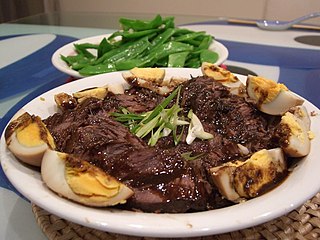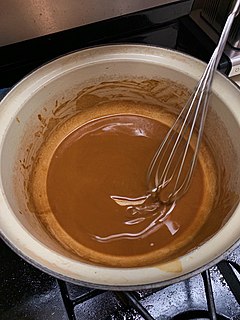
Braising is a combination-cooking method that uses both wet and dry heats: typically, the food is first sautéed or seared at a high temperature, then finished in a covered pot at a lower temperature while sitting in some (variable) amount of liquid. Braising of meat is often referred to as pot roasting, though some authors make a distinction between the two methods, based on whether additional liquid is added.

In cooking, a sauce is a liquid, cream, or semi-solid food, served on or used in preparing other foods. Most sauces are not normally consumed by themselves; they add flavor, moisture, and visual appeal to a dish. Sauce is a French word taken from the Latin salsa, meaning salted. Possibly the oldest recorded European sauce is garum, the fish sauce used by the Ancient Romans, while doubanjiang, the Chinese soy bean paste is mentioned in Rites of Zhou in the 3rd century BC.

Catalan cuisine is the cuisine from Catalonia. It may also refer to the shared cuisine of Roussillon and Andorra, the second of which has a similar cuisine to that of the neighbouring Alt Urgell and Cerdanya comarques and which is often referred to as "Catalan mountain cuisine". It is considered a part of western Mediterranean cuisine.

Gravy is a sauce, often made from the juices of meats that run naturally during cooking and often thickened with wheat flour or corn starch for added texture. The gravy may be further coloured and flavored with gravy salt or gravy browning or ready-made cubes and powders can be used as a substitute for natural meat or vegetable extracts. Canned and instant gravies are also available. Gravy is commonly served with roasts, meatloaf, rice, noodles, chips and mashed potatoes.

Roux is flour and fat cooked together and used to thicken sauces. Roux is typically made from equal parts of flour and fat by weight. The flour is added to the melted fat or oil on the stove top, blended until smooth, and cooked to the desired level of brownness. A roux can be white, blond (darker) or brown. Butter, bacon drippings or lard are commonly used fats. Roux is used as a thickening agent for gravy, sauces, soups and stews. It provides the base for a dish, and other ingredients are added after the roux is complete.

Blanquette de veau is a French veal ragout in which neither the veal nor the butter is browned in the cooking process. To refrain from browning meat and fat in this way, is to cook them en blanquette.

A velouté sauce is a savory sauce that is made from a roux and a light stock. It is one of the "mother sauces" of French cuisine listed by chef Auguste Escoffier in the early twentieth century, along with espagnole, tomato, béchamel, and mayonnaise or hollandaise. The term velouté is the French word for velvety.

Au jus is a French culinary term meaning "with juice". It refers to meat dishes prepared or served together with a light gravy, or broth, made from the fluids secreted by the meat as it is cooked. In French cuisine, cooking au jus is a natural way to enhance the flavour of dishes, mainly chicken, veal, and lamb. In American cuisine, the term is mostly used to refer to a light sauce for beef recipes, which may be served with the food or placed on the side for dipping.

Peanut sauce, satay sauce, bumbu kacang, sambal kacang, or pecel is an Indonesian sauce made from ground roasted or fried peanuts, widely used in cuisines worldwide.

Beef à la mode, or bœuf à la mode, is a French version of what is known in the United States as pot roast. It is a way to prepare a tougher cut of beef . The French culinary phrase à la mode used in the name of this dish is also encountered in other dishes such as Pie à la Mode.

Fricassee or fricassée is a stew made with pieces of meat that have been browned in butter that are served in a sauce flavored with the cooking stock. Fricassee is usually made with chicken, veal or rabbit, with variations limited only by what ingredients the cook has at hand.

Babi panggang refers to a variety of recipes for Indonesian grilled pork dishes, 'babi' meaning pig or pork, and 'panggang' meaning grilled or roasted in the Indonesian language.

Cap cai, sometimes spelled cap cay, is the Hokkien-derived term for a popular Chinese Indonesian and Peranakan stir-fried vegetable dish that originates from Fujian cuisine.

Togolese cuisine is the cuisine of the Togolese Republic, a country in Western Africa. Staple foods in Togolese cuisine include maize, rice, millet, cassava, yam, plantain and beans. Maize is the most commonly consumed food in the Togolese Republic. Fish is a significant source of protein. People in Togo tend to eat at home, but there are also restaurants and food stalls.

Crab in oyster sauce or oyster sauce crab is a Chinese seafood dish of crab served in savoury oyster sauce. It is a popular dish in Asia, that can be found from China, Indonesia, Singapore to the Philippines.

Wine sauce is a culinary sauce prepared with wine as a primary ingredient, heated and mixed with stock, butter, herbs, spices, onions, garlic and other ingredients. Several types of wines may be used, including red wine, white wine and port wine. Some versions are prepared using a reduction. Several types of wine sauces exist, and it is used in many dishes, including those prepared with seafood, poultry and beef. Wine sauces are associated with French cuisine.

Oyster sauce describes a number of sauces made by cooking oysters. The most common in modern use is a viscous dark brown condiment made from oyster extracts, sugar, salt and water thickened with corn starch. Some versions may be darkened with caramel, though high-quality oyster sauce is naturally dark. It is commonly used in Chinese, Thai, Malay, Vietnamese, and Khmer cuisine.

Ifumi is an Indonesian crispy deep fried thick noodle dish, popular in Maritime Southeast Asia, served in a thick savoury sauce with pieces of meat or seafood and vegetables. The dishes are to be served hot while the noodles are still crisp until the noodles are softened by the sauce and are ready to be eaten. The dish is one of the most popular noodle dishes in Chinese Indonesian cuisine. The type of noodle being used in this dish is the thick yi mein noodle, hence the origin of its name. It is quite similar to mie kering noodles from Makassar.

In French cuisine, the mother sauces, also known as grandes sauces or leading sauces, are a group of sauce recipes upon which many other sauces – "daughter sauces" or "small sauces" – are based. There have been different classifications of mother sauces dating back to the 19th century.



















